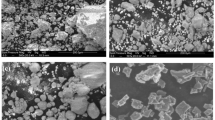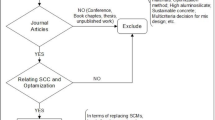Abstract
The substantial amount of CO2 emissions associated with the production of cement leads to an arising requisite for blending the cement with supplementary cementitious materials (SCMs). This study targets the production of a quaternary blended cement that exhibits the highest performance in terms of sustainability, mechanical and durability characteristics. Fly ash, glass powder and nanosilica of up to 30, 15 and 3%, respectively, were used in this study as SCMs. Dosages of the various SCMs used were optimized to maximize the 28th-day compressive strength and minimize chloride ion penetration, while minimizing the cement content using the response surface method. The ANOVA analysis showed high significance of the nanosilica and glass powder contents in determining the compressive strength, whereas fly ash content presumed insignificant effect on it. Fly ash, nanosilica and glass powder contents have been demonstrated significant in their effects on the resistance against chloride ions penetration. An optimal mixture containing 20% fly ash, 1.9% nanosilica and 15% glass powder as partial replacements of cement was found to have a sustainable concrete with the lowest cement content, 46.56 MPa of compressive strength and 688.98-C total chloride ion passing at 28-day age.









Similar content being viewed by others
References
Papatzani, S.; Paine, K.: Optimisation of low-carbon footprint quaternary and quinary (37% fly ash) cementitious nanocomposites with polycarboxylate or aqueous nanosilica particles. Adv. Mater. Sci. Eng. 2019, 5931306 (2019)
Müller, H.S.; Breiner, R.; Moffatt, J.S.; Haist, M.: Design and properties of sustainable concrete. Procedia Eng. 95, 290–304 (2014). https://doi.org/10.1016/j.proeng.2014.12.189
Awolusi, T.; Taiwo, A.; Aladegboye, O.; Oguntayo, D.: Materials Today: proceedings optimisation of quinary blended supplementary cementitious material for eco-friendly paving unit using taguchi orthogonal array design. Mater. Today Proc. 65, 2221–2227 (2022). https://doi.org/10.1016/j.matpr.2022.06.263
Du, S.; Zhao, Q.; Shi, X.: High-volume fly ash-based cementitious composites as sustainable materials : an overview of recent advances. Adv. Civil Eng. 2021, 1–22 (2021)
Fernández, Á.; Calvo, J.L.G.; Alonso, M.C.: Ordinary Portland cement composition for the optimization of the synergies of supplementary cementitious materials of ternary binders in hydration processes. Cem. Concr. Compos. 89, 238–250 (2018). https://doi.org/10.1016/j.cemconcomp.2017.12.016
Erdem, T.K.; Kırca, Ö.: Use of binary and ternary blends in high strength concrete. Constr. Build. Mater. 22(7), 1477–1483 (2008)
Wu, Z.; Naik, T.R.: Properties of concrete produced from multicomponent blended cements. Cem. Concr. Res. 32, 1937–1942 (2002)
Bonavetti, V.; Irassar, E.F.: Strength optimization of b tailor-made cement Q with limestone filler and blast furnace slag. Cem. Concr. Res. 35, 1324–1331 (2005). https://doi.org/10.1016/j.cemconres.2004.09.023
Lothenbach, B.; Scrivener, K.; Hooton, R.D.: Supplementary cementitious materials. Cem. Concr. Res. 41, 1244–1256 (2011)
Chindaprasirt, P.: Effect of fly ash fineness on compressive strength and pore size of blended cement paste. Cem. Concr. Compos. 27, 425–428 (2005). https://doi.org/10.1016/j.cemconcomp.2004.07.003
Kattoof, I.; Hassan, M.S.; Hasan, S.S.: Effects of liquid nitrogen cooling on the microstructure properties of nano-modified concrete under hot conditions. Arab. J. Sci. Eng. 47(10), 12569–12583 (2022). https://doi.org/10.1007/s13369-021-06496-5
Materials C.E.: Properties of nano-modified concrete cast and cured under cyclic freezing/low temperatures. Adv. Civil Eng. Mater. (2019)
Aswed, K.K.; Hassan, M.S.; Al-quraishi, H.: Optimisation and prediction of fresh ultra-high-performance concrete properties enhanced with nanosilica. J. Adv. Concr. Technol. 20(2), 103–116 (2022). https://doi.org/10.3151/jact.20.103
Harith, I.K.; Hassan, M.S.; Hasan, S.S., et al.: Optimization of liquid nitrogen dosage to cool concrete made with hybrid blends of nanosilica and fly ash using response surface method. Innov. Infrastruct. Solut. 8, 138 (2023). https://doi.org/10.1007/s41062-023-01107-8
Fallah, S.; Nematzadeh, M.: Mechanical properties and durability of high-strength concrete containing macro-polymeric and polypropylene fibers with nano-silica and silica fume. Constr. Build. Mater. 132, 170–187 (2017). https://doi.org/10.1016/j.conbuildmat.2016.11.100
Men, G.; Bonavetti, V.; Irassar, E.F.: Strength development of ternary blended cement with limestone filler and blast-furnace slag. Cem. Concr. Compos. 25, 61–67 (2003)
Fernandez A.; Sa M.; Alonso M.C.; Garcı J.L.: Ternary mixes with high mineral additions contents and corrosion related properties dedicated to professor Dr. Bernhard Elsener on the occasion of his 60th birthday. 9999, 1–9 (2012). https://doi.org/10.1002/maco.201206654.
De Weerdt, K.; Ben Haha, M.; Le Saout, G.; Kjellsen, K.O.; Justnes, H.; Lothenbach, B.: Cement and concrete research hydration mechanisms of ternary Portland cements containing limestone powder and fly ash. Cem. Concr. Res. 41(3), 279–291 (2011). https://doi.org/10.1016/j.cemconres.2010.11.014
De Weerdt, K.; Kjellsen, K.O.; Sellevold, E.; Justnes, H.: Cement & concrete composites synergy between fly ash and limestone powder in ternary cements. Cem. Concr. Compos. 33(1), 30–38 (2011). https://doi.org/10.1016/j.cemconcomp.2010.09.006
Radlinski, M.; Olek, J.: Cement & concrete composites investigation into the synergistic effects in ternary cementitious systems containing Portland cement, fly ash and silica fume. Cem. Concr. Compos. 34(4), 451–459 (2012). https://doi.org/10.1016/j.cemconcomp.2011.11.014
Lenth, R.V.: Response-surface methods in R, using rsm. J. Stat. Softw. 32(7), 1–17 (2009)
Montgomery, D.C.; Myers, R.H.; Carter, W.H., Jr.; Vining, G.G.: The hierarchy principle in designed industrial experiments. Qual. Reliab. Eng. Int. 21(2), 197–201 (2005)
Ghafari, E.; Costa, H.; Júlio, E.: RSM-based model to predict the performance of self-compacting UHPC reinforced with hybrid steel micro-fibers. Constr. Build. Mater. 66, 375–383 (2014)
Kumar, R.; Tiwari, O.P.: Experimental investigation of mechanical characterization and drilling of fabricated GFRP composites reinforced with Al2O3 micro particles. Int. J. Adv. Res. Ideas Innov. Technol. 4(4), 191–199 (2018)
IQS-No.5/2019: Portland cement. Central organization for standardization and quality control (COSQC), Iraq. 1–10 (2019)
ASTM C618-14: Standard specification for coal fly ash and raw 124 or calcined natural Pozzolan for use. Annual book Of ASTM standards American society for testing and materials. 1–5 (2014). https://doi.org/10.1520/C0618
IQS No.45/1984: Aggregate from natural sources for concrete and building construction. Central organization for standardization and quality control (COSQC), Iraq. 1–16 (1984)
ACI-304R: Guide for measuring, mixing, transporting, and placing concrete. (2000)
Aswed, K.K.; Harith, I.K.: An eco-sustainable production of cement mortar containing waste glass as partial replacement of cement. 924, 201–211 (2022)
Du, H., et al.: Waste glass powder as cement replacement in concrete concretes waste glass powder as cement replacement in concrete. J. Adv. Concr. Technol. 12, 468–477 (2014). https://doi.org/10.3151/jact.12.468
ASTM C192-16: Standard practice for making and curing concrete test specimens in the laboratory. Annual book of ASTM standards American society for testing and materials. 04(01), 1–8 (2016)
BS EN 12390-3: Testing hardened concrete-part 3: compressive of test specimens. 1–24 (2019)
ASTM C1202-97: Electrical indication of concrete’s ability to resist chloride ion penetration. Annual book of ASTM standards. 4(2), 639–644 (1997)
Montgomery, J.; Abu-lebdeh, T.M.; Hamoush, S.A.; Picornell, M.: Effect of nano silica on the compressive strength of harden cement paste at different stages of hydration. (March, 2016). https://doi.org/10.3844/ajeassp.2016.166.177
Isfahani, F.T.; Redaelli, E.; Lollini, F.; Li, W.; Bertolini, L.: Effects of nanosilica on compressive strength and durability properties of concrete with different water to binder ratios. Adv. Mater. Sci. Eng. (2016). https://doi.org/10.1155/2016/8453567
Haruehansapong, S.; Pulngern, T.; Chucheepsakul, S.: Effect of the particle size of nanosilica on the compressive strength and the optimum replacement content of cement mortar containing nano-SiO2. Constr. Build. Mater. 50, 471–477 (2014)
Said, A.M.; Zeidan, M.S.; Bassuoni, M.T.; Tian, Y.: Properties of concrete incorporating nano-silica. Constr. Build. Mater. 36, 838–844 (2012)
Senff, L.; Labrincha, J.A.; Ferreira, V.M.; Hotza, D.; Repette, W.L.: Effect of nano-silica on rheology and fresh properties of cement pastes and mortars. Constr. Build. Mater. 23(7), 2487–2491 (2009)
Florea, M.V.A.; Brouwers, H.J.H.: Chloride binding related to hydration products: part I: ordinary portland cement. Cem. Concr. Res. 42(2), 282–290 (2012)
Qu, Z.Y.; Yu, Q.L.; Brouwers, H.J.H.: Relationship between the particle size and dosage of LDHs and concrete resistance against chloride ingress. Cem. Concr. Res. 105, 81–90 (2018)
Mesbah, A., et al.: Crystal structure of Kuzel’s salt 3CaO·Al2O3·1/2CaSO4·1/2CaCl2·11H2O determined by synchrotron powder diffraction. Cem. Concr. Res. 41(5), 504–509 (2011)
Mesbah, A.; Cau-dit-Coumes, C.; Renaudin, G.; Frizon, F.; Leroux, F.: Uptake of chloride and carbonate ions by calcium monosulfoaluminate hydrate. Cem. Concr. Res. 42(8), 1157–1165 (2012)
Elakneswaran, Y.; Nawa, T.; Kurumisawa, K.: Electrokinetic potential of hydrated cement in relation to adsorption of chlorides. Cem. Concr. Res. 39(4), 340–344 (2009)
Wang, G.M.; Kong, Y.; Shui, Z.H.; Li, Q.; Han, J.L.: Experimental investigation on chloride diffusion and binding in concrete containing Metakaolin. Corros. Eng. Sci. Technol. 49(4), 282–286 (2014)
Shi, T.; Li, Z.; Guo, J.; Gong, H.; Gu, C.: Research progress on CNTs/CNFs-modified cement-based composites–a review. Constr. Build. Mater. 202, 290–307 (2019)
Liu, X., et al.: Effects of colloidal nano-SiO2 on the immobilization of chloride ions in cement-fly ash system. Cem. Concr. Compos. 110, 103596 (2020). https://doi.org/10.1016/j.cemconcomp.2020.103596. (July 2019)
ACI Committee 222: Protection of metals in concrete against corrosion. Aci 222R-01. 1–41 (2001)
Cheewaket, T.; Jaturapitakkul, C.; Chalee, W.: Long term performance of chloride binding capacity in fly ash concrete in a marine environment. Constr. Build. Mater. 24(8), 1352–1357 (2010)
Ipavec, A.; Vuk, T.; Gabrovšek, R.; Kaučič, V.: Chloride binding into hydrated blended cements: the influence of limestone and alkalinity. Cem. Concr. Res. 48, 74–85 (2013)
Ma, B., et al.: Utilization of pretreated fly ash to enhance the chloride binding capacity of cement-based material. Constr. Build. Mater. 175, 726–734 (2018)
Ma, B., et al.: Effect of TIPA on chloride immobilization in cement-fly ash paste. Adv. Mater. Sci. Eng. (2018). https://doi.org/10.1155/2018/4179421
Wang, Y.; Liu, C.; Tan, Y.; Wang, Y.; Li, Q.: Chloride binding capacity of green concrete mixed with fly ash or coal gangue in the marine environment. Constr. Build. Mater. 242, 118006 (2020). https://doi.org/10.1016/j.conbuildmat.2020.118006
Han, H.; Yu, R.; Li, B.; Zhang, Y.; Wang, W.; Chen, X.: Multi-objective optimization of corrugated tube with loose-fit twisted tape using RSM and NSGA-II. Int. J. Heat Mass Transf. 131, 781–794 (2019)
Aziminezhad, M.; Mahdikhani, M.; Memarpour, M.M.: RSM-based modeling and optimization of self-consolidating mortar to predict acceptable ranges of rheological properties. Constr. Build. Mater. 189, 1200–1213 (2018)
Derringer, G.; Suich, R.: Simultaneous optimization of several response variables. J. Qual. Technol. 12(4), 214–219 (1980)
Funding
No funding.
Author information
Authors and Affiliations
Corresponding author
Ethics declarations
Conflict of interest
The authors declare there are no competing interests.
Rights and permissions
Springer Nature or its licensor (e.g. a society or other partner) holds exclusive rights to this article under a publishing agreement with the author(s) or other rightsholder(s); author self-archiving of the accepted manuscript version of this article is solely governed by the terms of such publishing agreement and applicable law.
About this article
Cite this article
Harith, I.K. Optimization of Quaternary Blended Cement for Eco-Sustainable Concrete Mixes Using Response Surface Methodology. Arab J Sci Eng 48, 14079–14094 (2023). https://doi.org/10.1007/s13369-023-08071-6
Received:
Accepted:
Published:
Issue Date:
DOI: https://doi.org/10.1007/s13369-023-08071-6




